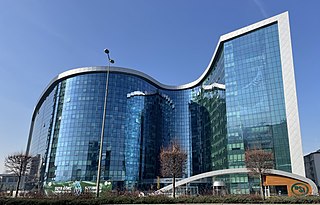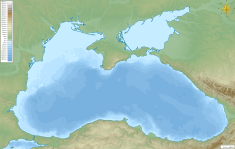
Turkey hosts more than three thousand endemic plant species, has high diversity of other taxa, and is almost entirely covered by three of the world's thirty-five biodiversity hotspots. Although some environmental pressures have been decoupled from economic growth the environment still faces many threats, such as coal and diesel fuel emitting greenhouse gases and deadly fine particulate air pollution. As of 2023 there is no fine particulate limit and coal in Turkey is subsidized. Some say the country is a pollution haven.

According to the Iran Petroleum Ministry, the proved natural gas reserves of Iran are about 1,201 trillion cubic feet (34.0 trillion cubic metres) or about 17.8% of world's total reserves, of which 33% are as associated gas and 67% is in non associated gas fields. It has the world's second largest reserves after Russia. As it takes approximately 5,850 cubic feet (166 m3) of gas to equal the energy content of 1-barrel (0.16 m3) of oil, Iran's gas reserves represent the equivalent of about 205 billion barrels (3.26×1010 m3) of oil.
The Doina gas field is a natural gas field located on the continental shelf of the Black Sea. It was discovered in 1990 and developed by Petrom. It began production in 1995 and produces natural gas and condensates. The total proven reserves of the Doina gas field are around 200 billion cubic feet (5.7 km³), and production is slated to be around 17.7 million cubic feet/day (0.5×105m³) in 2008.

Romania has proven natural gas reserves of 726 billion cubic meters and is ranked 30th among countries with proved reserves of natural gas. About 75% of Romania's natural gas resources are located in Transylvania, especially in Mureș and Sibiu counties. The largest natural gas field in Romania is the Deleni gas field discovered in 1912 and located in the Băgaciu commune in Mureș County with proven reserves of 85 billion cubic meters or 3 trillion cubic feet. Other important gas fields include the Filitelnic gas field, the Roman-Secuieni gas field, the Voitinel gas field, the Ghercești gas field and the Sărmașel gas field all with reserves larger than 10 billion cubic meters or 350 billion cubic feet. Currently Romania has the second largest natural gas reserves in the European Union just after the Netherlands.
Aphrodite gas field is an offshore gas field off the southern coast of Cyprus located at the exploratory drilling block 12 in the country's maritime Exclusive Economic Zone. and bordering the Yishai gas field, located in Israeli territorial waters. Located 34 kilometres (21 mi) west of Israel's Leviathan gas field, block 12 is believed to hold 3.6 to 6 trillion cubic feet of natural gas. In 2014, the reserve estimate for the quantity of natural gas held by Aphrodite was raised by 12% due to new data received from the Yishai prospect as reported by Delek Drilling to the Israel Securities Authority. The cost of the field's development was estimated to range from $2.5 billion to $3.5 billion.

Energy consumption per person in Turkey is similar to the world average, and over 85 per cent is from fossil fuels. From 1990 to 2017 annual primary energy supply tripled, but then remained constant to 2019. In 2019, Turkey's primary energy supply included around 30 per cent oil, 30 per cent coal, and 25 per cent gas. These fossil fuels contribute to Turkey's air pollution and its above average greenhouse gas emissions. Turkey mines its own lignite but imports three-quarters of its energy, including half the coal and almost all the oil and gas it requires, and its energy policy prioritises reducing imports.

The Trans-Anatolian Natural Gas Pipeline is a natural gas pipeline in Turkey. It is the central part of the Southern Gas Corridor, which connects the giant Shah Deniz gas field in Azerbaijan to Europe through the South Caucasus Pipeline and the Trans Adriatic Pipeline. The pipeline has a strategic importance for both Azerbaijan and Turkey. It allows the first Azerbaijani gas exports to Europe, beyond Turkey. It also strengthens the role of Turkey as a regional energy hub.
Gas flows from Turkey to Greece through a pipeline which is almost 300 km long. It is an incomplete transportation project that was proposed in the framework of the Southern Gas Corridor. It was proposed for the transportation of natural gas from Azerbaijan's Shah Deniz gas field Phase II to markets in Europe via Greece and Italy. The Turkey–Greece pipeline was completed in 2007 while the Greece–Italy pipeline was not built, due to the competing Trans Adriatic Pipeline.
The Domino gas field natural gas field is located on the continental shelf of the Black Sea. It was discovered in 2012 and developed by Petrom and ExxonMobil. It will begin production in 2020 and will produce natural gas and condensates. The total proven reserves of the Domino gas field are between 1.46 trillion cubic feet (42 km³) and 2.92 trillion cubic feet (84 km³), and production is slated to be around 630 million cubic feet/day (17.8×106m³) in 2020.
Skifska is a license block located in the Ukrainian zone on the continental shelf of the Black Sea. It was awarded in 2012 to a consortium consisting of Royal Dutch Shell, ExxonMobil, Petrom and Nadra.
The Odeske gas field natural gas field located on the continental shelf of the Black Sea. It was discovered in 2009 and developed by Chornomornaftogaz in cooperation with the China National Offshore Oil Corporation. It started commercial production on 5 September 2012. The total proven reserves of the Odesa gas field are around 746 billion cubic feet, and production is slated to be around 35 million cubic feet per day in 2015.

Hydroelectricity is a major source of electricity in Turkey, due to its mountainous landscape and many rivers. The country's main river basins are the Euphrates and Tigris. Over 700 hydropower plants have been built, and they make up about 30% of the country's electricity generating capacity. Annual generation varies greatly, and in rainy years lots of hydroelectric power can be generated. Government policies have generally supported building dams, but some are controversial in neighbouring countries, and some raise concerns about damage to the environment and wildlife.

Renewables supply a quarter of energy in Turkey, including heat and electricity. Some houses have rooftop solar water heating, and hot water from underground warms many spas and greenhouses. In parts of the west hot rocks are shallow enough to generate electricity as well as heat. Wind turbines, also mainly near western cities and industry, generate a tenth of Turkey’s electricity. Hydropower, mostly from dams in the east, is the only modern renewable energy which is fully exploited. Hydropower averages about a fifth of the country's electricity, but much less in drought years. Apart from wind and hydro, other renewables; such as geothermal, solar and biogas; together generated almost a tenth of Turkey’s electricity in 2022. Türkiye has ranked 5th in Europe and 12th in the world in terms of installed capacity in renewable energy. The share of renewables in Türkiye’s installed power reached to 54% at the end of 2022.
TurkStream is a natural gas pipeline running from Russia to Turkey. It starts from Russkaya compressor station near Anapa in Russia's Krasnodar Region, crossing the Black Sea to the receiving terminal at Kıyıköy.

Acarlar Floodplain Forest is a floodplain forest located in Sakarya Province, northwestern Turkey. It is a combination of seaside, lagoon, dunes and forest.

Turkey uses more electricity per person than the global average, but less than the European average, with demand peaking in summer due to air conditioning. Most electricity is generated from coal, gas and hydropower, with hydroelectricity from the east transmitted to big cities in the west. Electricity prices are state-controlled, but wholesale prices are heavily influenced by the cost of imported gas.

Climate changeinTurkey includes changes in the climate of Turkey, their effects and how the country is adapting to those changes. Turkey's annual and maximum temperatures are rising, and 2020 was the third hottest year on record. Turkey will be greatly affected by climate change, and is already experiencing more extreme weather, with droughts, floods and heatwaves being the main hazards.

Fossil gas supplies over a quarter of Turkey's energy. The country consumes 50 to 60 billion cubic metres of this natural gas each year, nearly all of which is imported. A large gas field in the Black Sea however started production in 2023.
Filyos Natural-gas Processing Plant is a plant under construction for natural-gas processing located at the port of Filyos in Çaycuma district, Zonguldak Province, Turkey.












